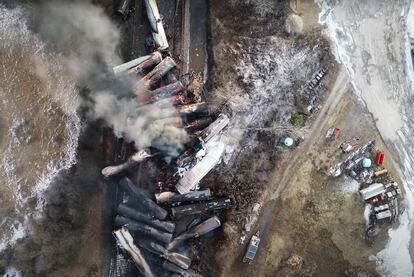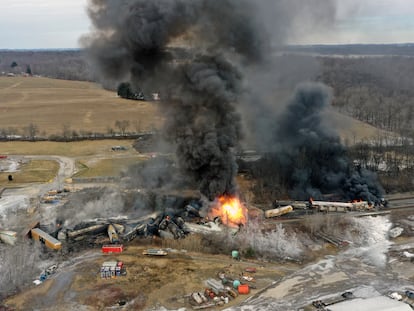Two fake news stories about the Ohio derailment, debunked
The Associated Press fact-checks claims that birds are ‘dropping dead’ because of the hazardous chemicals released after the train accident in East Palestine

A roundup of some of the most popular but completely untrue stories of the week in relation to the train derailment in East Palestine, Ohio. None of these are legit, even though they were shared widely on social media. The Associated Press checked them out. Here are the facts:
Claim: The Centers for Disease Control and Prevention removed information from its toxicological profile for vinyl chloride about how dangerous the gas is in regards to children, drinking water and cancer.
The facts: While a new toxicological profile released as a draft this month has been reformatted from the prior version, it does not omit such information nor downplay the dangers of vinyl chloride. In the weeks following the February 3 freight train derailment in Ohio that prompted officials to intentionally release and burn toxic vinyl chloride from five rail cars, a variety of conspiratorial claims about a government document on the gas have spread online. The prior vinyl chloride toxicological profile was released in 2006, and the CDC’s Agency for Toxic Substances and Disease Registry released a draft of an updated edition in February, which some baselessly asserted was suspicious timing.
Others went a step further to claim that the new version leaves out unspecified information about how the gas, which is used to make plastic products, impacts children, drinking water and cancer. But a comparison of the new draft with the 2006 version shows that while the new report has been significantly reformatted – with some chapters and subsections changed – both documents contain the same information about children, drinking water and cancer, even if not in the same places. Experts who reviewed the two reports concurred. “It’s just in a different format,” said Stephen Roberts, professor emeritus with the University of Florida and former director of the Center for Environmental and Human Toxicology. “There’s plenty of information in that profile about how dangerous vinyl chloride is. I don’t think that it plays down that aspect at all.”
For instance, the new draft omits a two-paragraph subsection titled “How Can Vinyl Chloride Affect Children?” But the new draft doesn’t leave out critical research concerning the dangers of vinyl chloride, and discussion of children’s susceptibility to the toxic effects of vinyl chloride are discussed at length elsewhere in the new draft. Both the new draft and the older version feature subsections devoted to vinyl chloride’s association with cancer, as well as references to the potential for children to be exposed to vinyl chloride through drinking water. “All the information is still in there,” said Michael Kleinman, an adjunct professor of environmental and occupational health at the University of California, Irvine. “They haven’t really changed the final conclusions.”
The new draft updates the 2006 version with the latest information published in scientific literature, Kristen Nordlund, a spokesperson for the CDC, wrote in an email to the AP. Nordlund said the agency has been working on the update to the vinyl chloride report over the past year and made it available for public comment on February 9, 2023. The process is “not related to the emergent situation in East Palestine,” she wrote.
Claim: A photo shows birds that “dropped dead” in Kentucky following the Ohio train derailment, and a video shows birds in northern Indiana that also died from the hazardous chemicals released after the derailment.
The facts: The photo, which shows several birds lying dead on a road, was taken in Little Rock, Arkansas, in 2018 and published in an article by the Arkansas Democrat-Gazette. The video misrepresents a clip of dead birds near New Carlisle, Indiana. Social media posts sharing photos and videos of dead birds in states beyond Ohio are spreading with false claims that the deaths are related to the recent burning of toxic chemicals following the Ohio derailment.
A Facebook user shared the photo supposedly showing birds in Kentucky, falsely claiming the incident was related. A reverse image search shows that the photo was featured in an article published by the Arkansas Democrat-Gazette on April 9, 2018. The photo’s caption states that several dead birds were found near an intersection in downtown Little Rock that month. A local ornithologist told the paper that the birds likely ate fermented berries, which can intoxicate them, causing them to fall and die.
Meanwhile, the widely shared video shows a flock of birds hanging side-by-side on a power line upside down, some with their beaks open. More birds can be seen lying on the ground. But the original video appeared on Facebook nearly two weeks before the derailment, making it impossible for the two incidents to be related. Shelly Lister Struss, a resident of Buchanan, Michigan, posted the video on January 22. She confirmed to the AP that she was the one who filmed it, about 2 miles (3 kilometers) outside of the center of New Carlisle, Indiana.
While the death of these birds was not due to the derailment, experts were uncertain of the precise cause. Marty Benson, a spokesperson for the Indiana Department of Natural Resources, told the AP that although the DNR “has not been on the site of this incident,” it is possible the birds “suffered electrocution from a power surge on the line.” Michael Bianski, a spokesperson for Indiana Michigan Power Company, said that a more plausible explanation is a phenomenon called conductor, or line, gallop – the sudden, rapid movement of power lines caused by wind gusts. “This can kill birds perched on power lines as whiplash from the motion can break their necks,” he wrote in an email to the Associated Press.
Sign up for our weekly newsletter to get more English-language news coverage from EL PAÍS USA Edition
Tu suscripción se está usando en otro dispositivo
¿Quieres añadir otro usuario a tu suscripción?
Si continúas leyendo en este dispositivo, no se podrá leer en el otro.
FlechaTu suscripción se está usando en otro dispositivo y solo puedes acceder a EL PAÍS desde un dispositivo a la vez.
Si quieres compartir tu cuenta, cambia tu suscripción a la modalidad Premium, así podrás añadir otro usuario. Cada uno accederá con su propia cuenta de email, lo que os permitirá personalizar vuestra experiencia en EL PAÍS.
¿Tienes una suscripción de empresa? Accede aquí para contratar más cuentas.
En el caso de no saber quién está usando tu cuenta, te recomendamos cambiar tu contraseña aquí.
Si decides continuar compartiendo tu cuenta, este mensaje se mostrará en tu dispositivo y en el de la otra persona que está usando tu cuenta de forma indefinida, afectando a tu experiencia de lectura. Puedes consultar aquí los términos y condiciones de la suscripción digital.
More information

Train crew had little warning before Ohio wreck, probe finds

Trump criticizes federal response to Ohio train derailment
Archived In
Últimas noticias
Most viewed
- Reinhard Genzel, Nobel laureate in physics: ‘One-minute videos will never give you the truth’
- Oona Chaplin: ‘I told James Cameron that I was living in a treehouse and starting a permaculture project with a friend’
- Pablo Escobar’s hippos: A serious environmental problem, 40 years on
- Why we lost the habit of sleeping in two segments and how that changed our sense of time
- Charles Dubouloz, mountaineering star, retires at 36 with a farewell tour inspired by Walter Bonatti








































